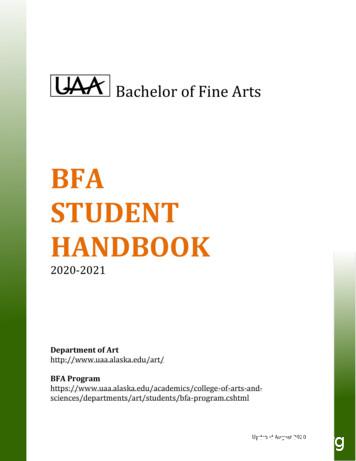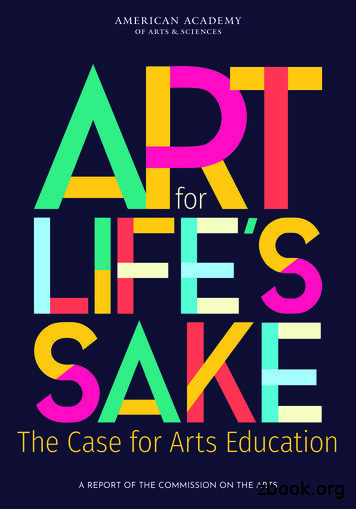FINE ARTS EDUCATION GEORGIA PERFORMANCE
Georgia Department of EducationFINE ARTS EDUCATIONGEORGIA PERFORMANCE STANDARDSTheatre ArtsGeorgia Depa rtment of Educa tionKa thy Cox, State Superintendent of SchoolsGeorgia Performance Standa rds Fine Arts – Thea tre Arts Educa tionJune 18, 2009 Pa ge 1 of 83
PrefaceGeorgia Performance Standards for Fine Arts EducationTABLE of CONTENTSSectionPage Number/sI.Introduction3II.Definition of Performance Standards3III.Benefits of Performance Standards3IV.Georgia Performance StandardsV.AssessmentVI.Application of Standards for Students With DisabilitiesVII.References/Consultants3-444-55This preface is included for all of the four areas of Fine Arts Education. The GeorgiaPerformance Standards (GPS) for Theatre Arts Education begins on page 6.Georgia Depa rtment of Educa tionKa thy Cox, State Superintendent of SchoolsGeorgia Performance Standa rds Fine Arts – Thea tre Arts Educa tionJune 18, 2009 Pa ge 2 of 83
Georgia Performance Standards for Fine Arts EducationPrefaceI. IntroductionDuring the school year 2008-2009, three committees for advisory, writing, and external reviewwere created for each of the four content areas of fine arts education including dance, music,theatre arts, and visual arts to draft Georgia Performance Standards for Fine Arts Education. TheNational Standards for Arts Education as referenced in the National Standards for ArtsEducation, Copyright 1994 by MENC: The National Association for Music Education, otherstates’ fine arts curriculum standards along with their State Department of Education fine artsspecialists and the Regional Educational Laboratory - South East Center (SERVE) allcontributed to the resource and research base. Committee members were recommended byschool district leadership and other experts in the field of fine arts education. Demographicallyand geographically, members represented a cross-section of Georgia and included members frombusiness, community, pre-kindergarten, elementary education, secondary education, postsecondary education, and state and national fine arts associations as listed within the standardsdocument for each content area.The Georgia Performance Standards for Fine Arts are based on The National Standards for ArtsEducation as referenced in the National Standards for Arts Education, Copyright 1994 byMENC: The National Association for Music Education. The National Standards outline whatevery K-12 student should know and be able to do in the arts. The standards were developed bythe Consortium of National Arts Education Association, through a grant administered by TheNational Association for Music Education (MENC).II. Definition of Standards:Standards are statements that define what students should know and be able to do uponcompletion of specific levels of instruction as well as how they will respond to theirenvironment. Standards serve as a guide for excellence and are differentiated from minimumcompetencies or outcomes because they describe the challenging goals for expanding andimproving education.III. Benefits of Performance Standards:As described in the National Standards for Arts Education, arts education benefits both studentand society. The arts cultivate the whole child, gradually building many kinds of literacy whiledeveloping intuition, reasoning, imagination, and dexterity into unique forms of expression andcommunication.IV. Georgia Performance Standards:Georgia’s performance standards provide clear expectations for instruction, assessment, andstudent work. They define the level of work that demonstrates achievement of the standards,Georgia Depa rtment of Educa tionKa thy Cox, State Superintendent of SchoolsGeorgia Performance Standa rds Fine Arts – Thea tre Arts Educa tionJune 18, 2009 Pa ge 3 of 83
enabling a teacher to know ―how good is good enough.‖ Performance standards isolate andidentify the skills needed to use the knowledge and skills to problem-solve, reason,communicate, and make connections with other information. They also tell the teacher how toassess the extent to which the student understands the standard and can manipulate and apply theinformation.Performance standards incorporate the content standard, which simply tells the teacher what astudent is expected to know (e.g., what concepts he or she is expected to master) and be able todo. Supporting elements are established and further define and support each content standard.Content standards and elements provide the foundation for developing three additional items:suggested student tasks, sample student work, and teacher commentary on student work.V. Assessment:Arts education places a high value on personal insight, individual achievement, and groupperformance and a broad range of assessment measures are used to assess whether a standard isbeing met. Because the standards are consensus statements about what an education in the artsshould contain, they provide a basis for student assessment and program evaluation. Thestandards support the arts in the ―academic‖ standing in that mere participation is not the same aseducation. The standards affirm that discipline and rigor are critical to high academicachievement. Academic achievement, knowledge, and skills can be measured in the arts– if notalways on a numerical scale, then by informed critical judgment. Performance-based assessmenthas long been used in the arts that include the practice of portfolio review in the visual arts andthe assessment of performance skills through auditions used in dance, music, and theatre. Thecontent of the standards for the arts attends to creating, performing, and responding which isconsistent with and informs the perspective of the National Assessment of Educational Progress(NAEP).VI. Application of Standards for Students with Disabilities:All students deserve access to the rich education and understanding that the arts provide,regardless of their background, talents, or disabilities. In an increasingly technologicalenvironment overloaded with sensory data, the ability to perceive, interpret, understand, andevaluate such stimuli is critical. The arts help all students to develop multiple capabilities forunderstanding and deciphering an image- and symbol- laden world. The necessity of assuring thatfine arts education services are provided to students with disabilities is in the implementing ofthe Individuals with Disabilities Education Act (IDEA). The IDEA requires that each child witha disability be afforded the opportunity to participate in the regular fine arts education programavailable to nondisabled children with specifically designed instruction (adapting, as appropriate,to the needs of the child, the content, methodology, or delivery of instruction) to address theunique needs of the child. Removal of children with disabilities is such that education in theregular classes with the use of supplementary aids and services cannot be achieved satisfactorily.At this point, special services and programming may be used as an appropriate alternative. Someof the elements supporting the standards may not be developmentally or functionally appropriatefor every child with a disability unless accommodations or modifications are implemented. Arteducators must be committed and prepared to make appropriate adjustments in the curriculum toGeorgia Depa rtment of Educa tionKa thy Cox, State Superintendent of SchoolsGeorgia Performance Standa rds Fine Arts – Thea tre Arts Educa tionJune 18, 2009 Pa ge 4 of 83
meet the unique needs of the learner. Making appropriate modifications to the curriculum tomeet individual needs allows for meaningful and relevant experiences provided in a safe andsecure environment.VII.References/Consultants:The National Standards for Arts Education as referenced in the NationalStandards for Arts Education, Copyright 1994 by MENC: The NationalAssociation for Music Education. New York: Rowan & Littlefield.Nancy Carr, Fine Arts Director, California Department of EducationLinda Lovins, Fine Arts Specialist, Florida Department of EducationChristie Lynch, Arts Education Consultant, North Carolina Department of PublicInstructionDeborah Reeve, Executive Director, National Art Education AssociationGeorgia Depa rtment of Educa tionKa thy Cox, State Superintendent of SchoolsGeorgia Performance Standa rds Fine Arts – Thea tre Arts Educa tionJune 18, 2009 Pa ge 5 of 83
Georgia Department of EducationTHEATRE ARTS EDUCATIONGEORGIA PERFORMANCE STANDARDSGeorgia Depa rtment of Educa tionKa thy Cox, State Superintendent of SchoolsGeorgia Performance Standa rds Fine Arts – Thea tre Arts Educa tionJune 18, 2009 Pa ge 6 of 83
TABLE of CONTENTSGeorgia Performance Standards for Theatre EducationSectionPage Number/sI.Acknowledge mentsTheatre Arts Advisory CommitteeTheatre Arts Writing CommitteeTheatre Arts External Review CommitteeII.Introduction8-910-11III. Georgia Performance Standards for Theatre Arts Education12-82Kindergarten .12-13First Grade .14-15Second Grade .16-17Third Grade 18-20Fourth Grade 21-22Fifth Grade 23-24Sixth Grade 25-27Seventh Grade 28-30Eighth Grade .31-33High School (Grades 9-12) 34-83a.b.c.d.e.f.g.Fundamentals of Theatre I and II 34-39Acting I-III . 40-48Advanced Drama I-IV . 49-58Theatre Literature I-II .59-63Musical Theatre I-III . 64-71Technical Theatre I-IV 72-81Theatre Marketing 82-83Georgia Depa rtment of Educa tionKa thy Cox, State Superintendent of SchoolsGeorgia Performance Standa rds Fine Arts – Thea tre Arts Educa tionJune 18, 2009 Pa ge 7 of 83
I. Acknowledge mentsNameCommitteeRepresentingDr. Kiran NarkerFacilitator/ConsultantDeKalb CountyDr. Janice AkersMelissa ArasiJudy BerlageCary BragueKathleen BryantDr. Larry BunchJake CullensRenee DenneyDavid DixonWendy EdwardsKaren EricksonKathy GillcristDr. Robert GlorPaula GuyBronwyn JardinCarol JonesNoel JordanArietha LockhartElise LynchBonnie MarshallBarry Stewart MannLeanne MauleMary MazarkyLynn McIntyreNancy MeyerSusan MerrittPam MilliceMiranda MurpheyBarbara O’BrienAnne OstholthoffTara PerryShelli PhillipsFrank PruetDavid RectorClaire RitzlerMegan RoddenberryJennifer RyanAdvisorAdvisorExternal ReviewerAdvisor/GaDOEExternal ReviewerExternal ReviewerWriterExternal ReviewerWriterAdvisorExternal ReviewerWriterExternal ReviewerExternal ReviewerWriterWriterExternal ReviewerExternal ReviewerAdvisorWriter/AdvisorExternal ReviewerWriterAdvisorAdvisorExternal ReviewerExternal ReviewerAdvisor /External ReviewerExternal ReviewerAdvisor/External xternal ReviewerWriterWriterEmory UniversityCobb CountyCobb CountyGovernor’s Honors ProgramMorgan CountyCatoosa CountyGwinnett CountyFulton CountyHaralson CountyLee CountyCreative Directions, Inc.Hart CountyDeKalb CountyBartow CountyHouston CountyWoodruff Arts Center Alliance TheatreMeriwether CountyDeKalb CountyGaDOE Special EducationGaDOE (AP, SAT, PSAT, Gifted)Alliance TheatreGA Teacher of Year 2009GA Dept. of Early Care and LearningGA Parent Teacher AssociationAlliance TheatreCoalition for Arts EducationBusiness/Creating PrideMcDuffie CountyBusiness/Georgia Public BroadcastingBusiness/Exec. Dir. Creating PrideWoodruff Arts CenterTift CountyCobb CountyFulton CountyAlliance TheatreDalton Public SchoolsMarietta City SchoolsGeorgia Depa rtment of Educa tionKa thy Cox, State Superintendent of SchoolsGeorgia Performance Standa rds Fine Arts – Thea tre Arts Educa tionJune 18, 2009 Pa ge 8 of 83
NameCommitteeRepresentingGina SabinDr. Dean SlusserShirley SpencerKimberly StaplesCyndy StephensRobin SuterTiffany TindallPam WareEric WearneDeborah WhiteExternal ReviewerWriter/AdvisorExternal ReviewerWriterAdvisorAdvisorAdvisorExternal ReviewerAdvisorAdvisorShelley YeatmanAdvisorBartow CountyCamden CountyGlynn CountyBuford City SchoolsGA Professional Standards CommissionGA Parent Teacher AssociationCobb CountyGainesville City SchoolsGA Office of Student AchievementGA Association of Curriculum andInstructional SupervisorsGA Dept. of Early Care and LearningGeorgia Depa rtment of Educa tionKa thy Cox, State Superintendent of SchoolsGeorgia Performance Standa rds Fine Arts – Thea tre Arts Educa tionJune 18, 2009 Pa ge 9 of 83
II.IntroductionFor centuries and across myriad cultures, the composite artistic skills and power of the TheatreArts have served a variety of sociological and cultural functions. As a conduit forcommunication, a platform for ornate displays, and a non-discriminatory venue for onstageentertainments, subtle satires, political ideologies, intellectual slugfests, and the pervasivemusical delights of Broadway, Theatre has been and continues to be, for the actor and audiencealike, a playground of the imagination, an agent of social change, and an educational tool.As a powerful educational tool, Theatre addresses a child’s complex intellectual, social,emotional, physical, and cultural world. As an intellectual tool, Theatre not only teaches factsand figures, but routinely invites analysis, judgment, and synthesis. As a social tool, Theatreencourages cooperative learning, team work, organization, and leadership skills, however,Theatre’s forte is in the emotional arena, where participants are able to not only express emotionin a safe environment, but more pertinently, able to learn how to calibrate their emotionalresponses to various stimuli. In the physical realm, Theatre endows a ll participants with insightand physicality, offering them the opportunity to explore areas of social interaction unavailablein ―reality.‖ And finally, Theatre plays the dual role of cultural transmitter and filter,disseminating cultural codes and values to the younger generation.Accomplished educators exploit the enormous potential of the Theatre Arts by seamlesslyintegrating all aspects of the art form: script writing, acting, designing, directing, researching,comparing art forms, analyzing, critiquing, and understanding contexts. Further, in order todevelop theatre literacy and a career focus, accomplished educators teach students to see thecreated world of theatre through multiple perspectives: the playwright, actor, designer, director,and discerning audience member. Finally, in order to enhance the intellectual aspect of Theatre,accomplished educators encourage students to view (and deconstruct) dramatic works as not onlya collection of denotative and connotative meanings, but as a metaphoric vision of life thatinvites, supports, and celebrates varied interpretations.Georgia Depa rtment of Educa tionKa thy Cox, State Superintendent of SchoolsGeorgia Performance Standa rds Fine Arts – Thea tre Arts Educa tionJune 18, 2009 Pa ge 10 of 83
The Georgia Performance Standards (GPS) Coding System for Theatre Arts:The coding system developed for the performance standards in Theatre Arts has a uniquecorresponding code made up of numbers and letters. The codes include:o Subject area (Theatre Arts, delineated by the letters ―TA‖)o Grade level or band (ES Elementary School; MS Middle School;HS High School)o Grade bands for the K-5 grades (grade bands K-1; 2-3; 4-5)o Letter abbreviations of the domains (FT Fundamentals of Theatre, A Acting,AD Advanced Drama; TL Theatre Literature; MT Musical Theatre;TT Technical Theatre)o Numbering system for the standard within that domain (e.g., 1, 2, 3)o The elements supporting the standard denoted by lower case letters (e.g., a, b, c)Coding examples:The code for the first elementary standard and corresponding element ―a‖ for Kindergartenthrough first grade in the Theatre Arts is TAESK-1.1. aTheatre Arts, Elementary School, Grades K-1, Standard 1, Element aThe coding for the ninth middle school standard and corresponding element ―b‖ for seventhgrade is TAMS7.9.bTheatre Arts, M iddle School, Grade 7, Standard 9, Element bThe coding for the second standard and corresponding element ―c‖ within the Acting domain forhigh school Acting Level 1, is TAHSAI.2.cTheatre Arts, High School, Acting Level I, Standard 2, Element cGeorgia Depa rtment of Educa tionKa thy Cox, State Superintendent of SchoolsGeorgia Performance Standa rds Fine Arts – Thea tre Arts Educa tionJune 18, 2009 Pa ge 11 of 83
III. THEATRE: GEORGIA PERFORMANCE STANDARDSGRADE: KTHEATRE ARTS KTAESK.1 Analyzing and constructing meaning from theatrical experiences, dramatic literature,and electronic mediaa. Identifies simple theater vocabularyb. States the difference between pretend and realc. Identifies how theatre experiences are like and unlike real lifeTAESK.2 Developing scripts through improvisation and other theatrical methodsa. Identifies dramatic elements including character, setting, problem, plot, resolution,beginning- middle-endb. Retells storiesc. Sequences plot events for dramatizationsd. Generates original ideas for dramatizationse. Uses the playwriting process: pre-write/pre-play event; preparing to write/dramatize;writing/dramatizing story; evaluation, reflection, editing; rewrite/replay dramatizationTAESK.3 Acting by developing, communicating, and sustaining roles within a variety ofsituations and environmentsa.b.c.d.e.f.Uses voice to communicate ideas and emotionsUses body to communicate ideas and emotionsUses imagination to create, revise or add to ideasCollaborates and cooperates in theatre experiencesDemonstrates skills of the mind: imagination, focusing, and concentration.Assumes roles in a variety of dramatic forms, such as narrated story, pantomime,puppetry and role playg. Names the five sensesTAESK.4 Designing and executing artistic and technical elements of theatrea. Identifies and uses personal and partner space; playing space and audience spaceb. Uses simple objects and materials in dramatizationsc. Uses sound in dramatizationsTAESK.5 Directing by conceptualizing, organizing, and conducting rehearsals for performancea. Follows directions in theatre experiencesb. Contributes to planning for dramatizationsc. Listens to others with respect and courtesyGeorgia Depa rtment of Educa tionKa thy Cox, State Superintendent of SchoolsGeorgia Performance Standa rds Fine Arts – Thea tre Arts Educa tionJune 18, 2009 Pa ge 12 of 83
TAESK.6 Researching cultural and historical information to support artistic choicesa.Uses school resources including text, pictures, technology and people to developdramatizationsTAESK.7 Integrating various art forms, other content areas, and life experiences, to createtheatrea. Identifies visual art, music, dance, and/or electronic media in dramatizationsb. Dramatizes life experiencesTAESK.8 Examining the roles of theatre as a reflection of past and present civilizationa. Describes why people dramatize storiesb. Identifies theatre experiences in the communityTAESK.9 Exploring the relevance of theatre to careersa. States that people have jobs in theatreb. Names actors and acting as a career in theaterTAESK.10 Critiquing various aspects of theatre and other media using appropriate supportingevidencea.b.c.d.Expresses personal preferences about theatre experiencesDescribes what is seen, felt, and heard in a theatre experienceAsks questions about what is seen, felt, and heard in a theatre experienceReflects on theatre experiences using a variety of written, graphic, non- verbal, andoral responsesTAESK.11 Engaging actively and appropriately as an audience member in theatre or othermedia experiencesa. Participates as audienceb. Identifies the basic elements of theatre etiquette.Georgia Depa rtment of Educa tionKa thy Cox, State Superintendent of SchoolsGeorgia Performance Standa rds Fine Arts – Thea tre Arts Educa tionJune 18, 2009 Pa ge 13 of 83
GRADE: 1THEATRE ARTS 1TAES1.1 Analyzing and constructing meaning from theatrical experiences, dramatic literature,a
Feb 11, 2010 · Georgia Department of Education Kathy Cox, State Superintendent of Schools Georgia Performance Standards Fine Arts – Theatre Arts Education June 18, 2009 Page 2 of 83 Preface Georgia Performance Standards for Fine Arts Education
Digital Photo I Fine Arts or Elective (if all Fine Arts credits are met) Digital Photo II Fine Arts or Elective (if all Fine Arts credits are met) Graphic Design Fine Arts or Elective (if all Fine Arts credits are met) Fine Art
Oct 22, 2014 · ART ART 111 Art Appreciation ART 1301 Fine Arts ART 113 Art Methods and Materials Elective Fine Arts . ART 116 Survey of American Art Elective Fine Arts ART 117 Non Western Art History Elective Fine Arts ART 118 Art by Women Elective Fine Arts ART 121 Two Dimensional Design ART 1321 Fine Arts ART
Elyse (Ginger Cooley) Applegate ARTS 332B 786-1683 Marketing and Public Relations e.a@alaska.edu Manager, Performing and Fine Arts Division Cedar Cussins ARTS 333 786-4890 Performing & Fine Arts cedar@alaska.edu Building Manager ART STUDIOS DRAWING Arts 101 (no phone) PAINTING Arts 102 786-1352 CERAMICS-HANDBUILT Arts 106 786-1246
A LETTER FROM THE PRESIDENT OF THE AMERICAN ACADEMY v THE ARTS AND PUBLIC EDUCATION 1 Introduction 1 Prior Research on the Benefits of Arts Education 4 Access and Gaps in Arts Education 5 Now Is Our Moment 9 Sidebar: Arts Education in Our Schools and Communities 9 THE VALUES OF ARTS EDUCATION 10 Arts Education Builds Well-Rounded Individuals 11 Arts Education Broadens Our Understanding of and .
A Fine, Fine School Independent Reading R e a d e rs eGuid RRR eee adddeeerrrr’’ss GG u ii d e A Fine, Fine School The Fine, Fine School Times Tillie is writing an article for the school newspaper, The Fine, Fine School Times. Her article will tell the real story. Use the text and illustrations to help her write the article. Read pages 20–23.
Visual Arts Standards of Learning Foreword The Fine Arts Standards of Learning in this publication represent a major development in public education in Virginia. Adopted in April 2006 by the Virginia Board of Education, these standards emphasize the importance of instruction in the fine arts—dance arts, music, theatre arts, and visual arts—
2014 – 2015. 2 2014-2015 ARTS CONCENTRATIONS AT DURHAM SCHOOL OF THE ARTS ARTS: Music ARTS: Theatre Arts ARTS: Dance ARTS: Visual Arts ARTS: CTE ARTS: Writing . portfolio to Scholastic Art & Writing Awards _ Newspaper Journalism *Completer Options 1) Editor or Co-Editor . AP Art History - 54487X0Y Writing Through Literature 2-10272YW2 .
Zecharia Sitchin these aliens had been coming here for a long time and even brought civilization to Planet Earth. Civilization? No, barbarism, cursed Roland. Today, with millions of claimed UFO sightings encounters with aliens alleged kidnappings investigators everywhere were coming right out and calling it an epidemic.























